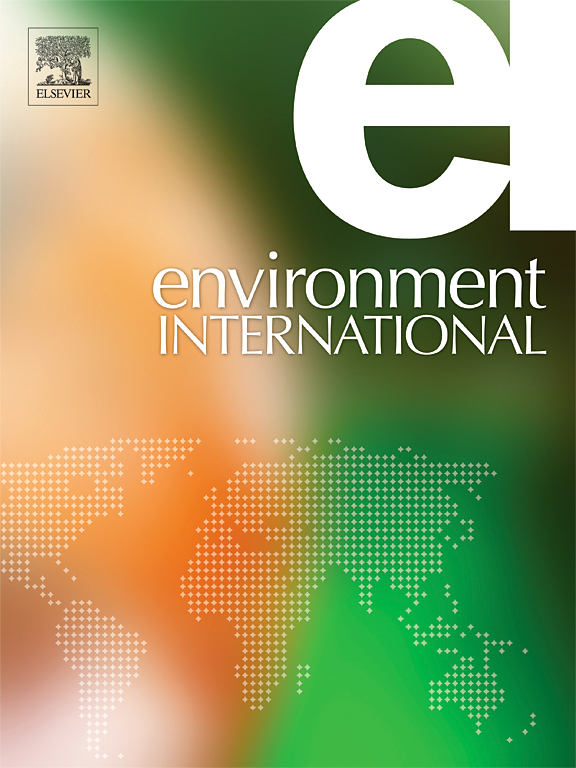射频电磁场对哺乳动物体外细胞的遗传毒性:系统综述与叙述性综述
IF 10.3
1区 环境科学与生态学
Q1 ENVIRONMENTAL SCIENCES
引用次数: 0
摘要
背景过去几十年来,人们对暴露于无线通信技术发出的射频电磁场(RF-EMF,100 kHz - 300 GHz)可能对人类健康造成的不利影响表示极大关注。2011 年,国际癌症研究机构将射频电磁场归类为可能对人类致癌的物质,但强调证据不足,远未得出结论。目标对射频-电磁场在体外实验模型中诱导的基因毒性效应的科学文献进行系统综述。总体目标是评估哺乳动物细胞培养物中诱导效应的可信度和证据水平。方法有关纳入研究的资格标准、信息来源和评估偏倚风险的方法的全部详情,请参阅我们发布的协议(Romeo 等,2021 年)。我们将 NCBI PubMed、Web of Science 和 EMF-Portal 数据库作为信息来源(最后搜索日期为 2022 年 12 月 31 日)。在撰写系统综述时,我们遵循了美国国家毒理学计划--健康评估与转化办公室(NTP-OHAT)提供的指南,并对体外研究的评估进行了调整。我们根据有意义的组别(终点)和子组别(暴露参数)对数据进行了分类,从而对证据进行了叙述性综合。本报告(包括摘要)符合 PRISMA 2020(系统综述和 Meta 分析首选报告项目)指南。从提取的数据中,我们确定了 1111 项实验(定义为不同生物和电磁参数的独立特定组合)。绝大多数(80%)被审查的实验并未显示出暴露于射频-电磁场在统计学上有显著的遗传毒性影响,大多数 "阳性 "研究被评为中低质量,在关键的偏倚领域被评为阴性。据我们所知,这是首次对哺乳动物细胞培养过程中与射频-电磁场暴露有关的遗传毒性效应的科学文献进行系统综述,由于采用了透明的报告方法、预先确定的纳入标准以及对偏倚敏感性的正式评估,该综述证实并加强了以往对这一特定主题的综述结论。所纳入证据的局限性在于经常仅以图表形式报告研究结果,而且实验数据的异质性很大,因此无法进行荟萃分析。结论 在仅限于报告暴露对结果有显著影响的研究的评估中,我们对射频-电磁场在哺乳动物细胞中诱导基因毒性效应的证据水平总体评估为 "低 "置信度。然而,80% 的实验表明,无论暴露特征、水平和持续时间如何,射频暴露对绝大多数终点,尤其是不可逆终点没有影响(无影响的中度证据)。因此,我们得出结论,对本综述所含论文的分析(尽管只是定性分析)表明,射频暴露不会增加体外遗传毒性效应的发生。该项目由意大利工人赔偿局(INAIL)在与意大利卫生研究院合作的 CRA 框架内支持,名为 "BRiC 2018/06 - 电磁场致癌性的科学证据"。本文章由计算机程序翻译,如有差异,请以英文原文为准。
Genotoxicity of radiofrequency electromagnetic fields on mammalian cells in vitro: A systematic review with narrative synthesis
Background
Over the last decades, great concern has been raised about possible adverse effects to human health due to exposures to radiofrequency electromagnetic fields (RF-EMF, 100 kHz – 300 GHz) emitted by wireless communication technologies. In 2011 the International Agency for Research on Cancer classified RF-EMF as possibly carcinogenic to humans, highlighting that the evidence was weak and far from conclusive. Updated systematic reviews of the scientific literature on this topic are lacking, especially for mechanistic studies.
Objectives
To perform a systematic review of the scientific literature on genotoxic effects induced by RF-EMF in in vitro experimental models. The overall aim is to assess the confidence and level of evidence of the induced effects in mammalian cell cultures.
Methods
Full details regarding the eligibility criteria, information sources, and methods developed to assess risk of bias in the included study, are reported in our published protocol (Romeo et al. 2021). The databases NCBI PubMed, Web of Science, and EMF-Portal were used as information sources (last searched on 31st December 2022). In developing the systematic review, we followed the guidelines provided by the National Toxicology Program-Office of Health Assessment and Translation (NTP-OHAT), adapted to the evaluation of in vitro studies. A narrative synthesis of the body of evidence was performed by tabulating data classified according to meaningful groups (endpoints) and sub-groups (exposure parameters). This report, abstract included, conforms to the PRISMA 2020 (Preferred Reporting Items for Systematic reviews and Meta-Analyses) guidelines.
Results
Out of 7750 unique records identified, 159 articles were eligible for inclusion. From the extracted data, we identified 1111 experiments (defined as independent specific combinations of diverse biological and electromagnetic parameters). The large majority (80%) of experiments reviewed did not show statistically significant genotoxic effects of RF-EMF exposures, and most “positive” studies were rated as of moderate to low quality, with negative ratings in the key bias domains. A qualitative evidence appraisal was conducted at the endpoint level, and then integrated across endpoints.
Discussion
To the best of our knowledge, this is the first systematic review of the scientific literature on genotoxic effects in mammalian cell cultures in relation to RF-EMF exposure, which confirms and strengthens conclusions from previous syntheses of this specific topic thanks to the use of transparently reported methods, pre-defined inclusion criteria, and formal assessment of susceptibility to bias. Limitations of the evidence included the frequent reporting of findings in graphical display only, and the large heterogeneity of experimental data, which precluded a meta-analysis.
Conclusions
In the assessment restricted to studies reporting a significant effect of the exposure on the outcome, we reached an overall assessment of “low” confidence in the evidence that RF-EMF induce genotoxic effects in mammalian cells. However, 80% of experiments reviewed showed no effect of RF exposure on the large majority of endpoints, especially the irreversible ones, independently of the exposure features, level, and duration (moderate evidence of no effect). Therefore, we conclude that the analysis of the papers included in this review, although only qualitative, suggests that RF exposure does not increase the occurrence of genotoxic effects in vitro.
Framework and funding
This systematic review addresses one of the evidence streams considered in a larger systematic review of the scientific literature on the potential carcinogenicity of RF-EMF, performed by scientists from several Italian public research agencies. The project is supported by the Italian Workers’ Compensation Authority (INAIL) in the framework of the CRA with the Istituto Superiore di Sanità “BRiC 2018/06 – Scientific evidence on the carcinogenicity of electromagnetic fields”.
求助全文
通过发布文献求助,成功后即可免费获取论文全文。
去求助
来源期刊

Environment International
环境科学-环境科学
CiteScore
21.90
自引率
3.40%
发文量
734
审稿时长
2.8 months
期刊介绍:
Environmental Health publishes manuscripts focusing on critical aspects of environmental and occupational medicine, including studies in toxicology and epidemiology, to illuminate the human health implications of exposure to environmental hazards. The journal adopts an open-access model and practices open peer review.
It caters to scientists and practitioners across all environmental science domains, directly or indirectly impacting human health and well-being. With a commitment to enhancing the prevention of environmentally-related health risks, Environmental Health serves as a public health journal for the community and scientists engaged in matters of public health significance concerning the environment.
 求助内容:
求助内容: 应助结果提醒方式:
应助结果提醒方式:


